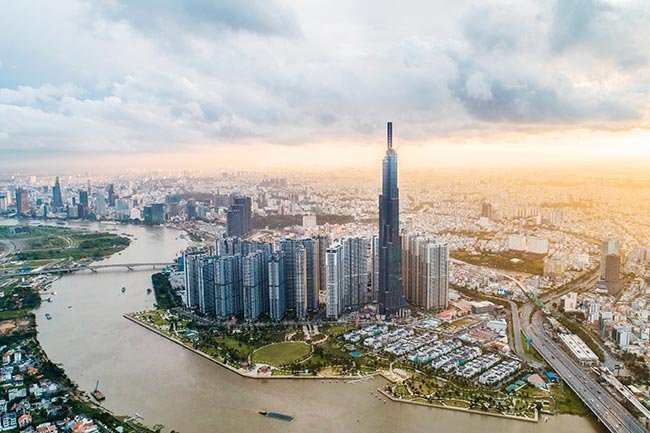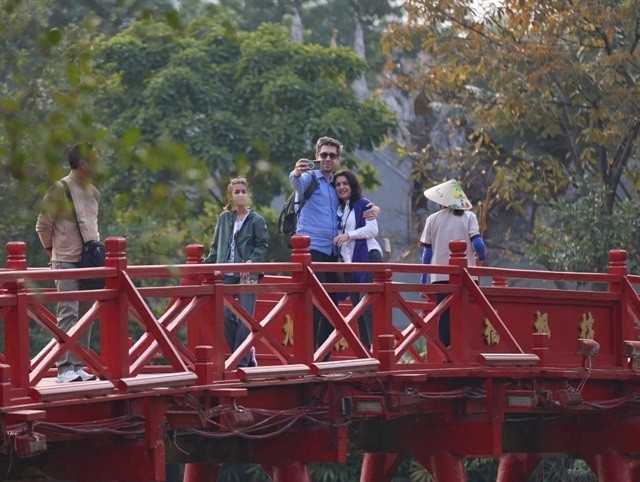Vietnam’s tourism strength: A realistic assessment
This month, Vietnam is expected to welcome the fifteen millionth foreign visitor of the year, an impressive figure for the tourism industry. However, industry insiders hold that the growth in visitor number is not an indicator of the internal strength of the tourism industry.

Foreign tourists at the Bach Dang Speed Ferry Terminal in HCMC’s District 1
South Korea’s biggest low-cost air carrier Jeju Air will open an air route between Daegu City and Danang City late this month, with seven services per week. Along with this new route, Jeju Air will increase flights between Muan and Danang to seven per week, taking the number of its air routes between South Korea and Vietnam to seven and the total number of flights to 63 per week.
Jeju Air has joined Vietnam’s aviation market for only four years, but its seat supply has increased very fast, from 150,000 seats in 2015 to 450,000 seats in 2017 and 720,000 seats in October 2018. Yang Seong Jin, public relations manager of Jeju Air, said three years ago, Japan, China and Thailand were three destinations that attracted the most Korean tourists, but Vietnam has now dethroned Thailand to become the third most attractive destination to Korean tourists, and Danang is the first place for their trips to Vietnam. “Previously, we could not imagine that so many Koreans would visit Danang like now,” Yang said. “Our revenue from the Vietnam market is very good, second only to the biggest market Japan.”
South Korea is the second biggest market for Vietnam tourism after China, but it has the highest growth rate. According to statistics of the Vietnam National Administration of Tourism, more than 2.8 million Korean tourists visited Vietnam in the first 10 months of this year, rising 48.3% over the same period last year. Nine airlines are operating air routes between the two countries, with 383 flights per week.
The massive arrival of Korean tourists in Danang and Quang Nam has changed the local tourism drastically. The Bay Mau Cam Thanh, a nipa palm forest listed as a historical site in the ancient town of Hoi An, is no longer a tranquil place with some coracles transporting western tourists for a leisure trip like it was several years ago. The number of coracles has now amounted to several hundred.
Hoi An’s business scene has also changed. A coconut seller can now say “Sam man tong” (VND30,000) to offer the stuff to a Korean tourist. The use of western languages to offer goods is a thing of the past. Local sellers have quickly adopted a new language, Korean, to serve tourists from the northeast Asian country.
The growth of Korean tourist arrivals partly reflects the impressive growth of Vietnam tourism industry. Last year, the country for the first time welcomed more than 12.9 million international visitors, an increase of 29.1% over 2016. If the fifteen millionth visitor comes this month as expected, 2018 will continue to be a year of hot growth for the tourism industry and show the strong attraction of Vietnam to international tourists.
“After the International Travel Expo in HCMC in September, I led a number of Italian partners to Vietnam, among them are some big wholesalers which have yet to sell tours to Vietnam,” said Dong Hoang Thinh, director of Dong Thi Limited Liability Company. “About two or three weeks later, they have continuously made inquire to design tours. They said Vietnam is an emerging destination and they do not want to be late.”
Weak internal strength
The strong growth in tourist number does not make many businesspeople feel satisfied, however, as there are a host of problems regarding tourist products, prices, planning and marketing to be solved to create sustainable competitiveness for a tourist destination.
Vietnam has yet to take initiative in tourist attraction. The market is heavily tilted towards Chinese and Korean tourists. Failure to take initiative in market exploitation and operation may lead to tourist decline like the experiences of Khanh Hoa and Binh Thuan provinces several years ago.
In the first 10 months of this year, the country welcomed more than 12.8 million international visitors, including more than seven million Chinese and Korean tourists. There are 383 weekly flights from South Korea and 500 weekly flights from China to Vietnam. Most of the flights are chartered flights bringing Korean and Chinese tourists to seaside spots operated by Chinese and Korean businesses. Things are the same with the Russian market. Russian travel firms hold a dominant share of this market. Some Russian businesses also operate other services like accommodation to offer a complete package. The rise or fall in Russian tourists depends largely on those enterprises; so the destination will take a hit when there is a change in this market.
A representative from a travel firm said the Russian market may falter, as Russian travel businesses have not received many customers as compared with early this year and have reduced chartered flights. A number of scheduled flights to HCMC have been canceled, and there is no plan to kickstart the market because of rising tour prices.
Early this year, the exchange rate between the U.S. dollar and the Russian ruble was 55-60 rubles per dollar, but the rate has now increased to 65-68 rubles per dollar. Meanwhile, many hotels and some services in Vietnam are raising prices, which make tour prices higher. Fewer tour buyers have forced tour operators to cut flights to retain profit. However, management authorities have yet to realize the situation to come up with solutions to minimize the decline.
According to some travel companies, the annual price hike, few new products and lack of orientation for the market and services are problems adversely affecting the internal strength of the local tourism industry. The annual hike of tour prices is creating a big pressure for the competitiveness of Vietnam’s tourist destinations. Meanwhile, tourist products have so far adopted little changes. In addition to main products like seaside travel and sightseeing, travel companies do not have many new services to offer.
Bui Viet Thuy Tien, CEO of Asian Trails Co., said tour prices for the tourist season 2019-2020 may have to increase 3-5% because hotel prices in some destinations like Phan Thiet have risen by 3-5% and Phu Quoc 5-8%, and the transport cost has risen 5-10%. “The continuous price rise makes it hard for a destination to attract tourists,” she said, adding that the price of a room in a five-star hotel in Kuala Lumpur is US$120 per night while it must be US$300 for the same room in HCMC where there are few hotels of such standards.
Tien also mentioned the need for long-term campaigns to develop different customer segments and accompanying services. She said tourism management agencies should identify where to develop mass tourism and where to serve special tourists for appropriate investment to bring about better economic efficiency. For example, western tourists are very keen on Sapa but less have come to the hillside resort now because it is jam-packed with tourists. Tour operators therefore have to direct them to some nearby areas and Mu Cang Chai, but these places do not have enough accommodation and other services.
The lack of dynamism in marketing activities is also a chronic problem of the tourism industry. Marketing programs only introduce general destinations, while there are no promotions for each specific market as well as activities regarding businesses, which bring customers to a destination.
Meanwhile, neighboring countries are making constant efforts to attract tourists. Singapore has sent out a new message inviting sociable Vietnamese to visit bars and clubs and to experience the hectic nightlife in the island country. Representatives from tourism promotion agencies in Japan, Thailand and South Korea have continuously worked with Vietnamese travel firms to offer financial support for promotion and introduce seasonal tourism products. Most big events are exploited for promotion and introduction of new tourist products to kickstart the market. “At the World Travel Market in the UK in early November, many partners were excited to know that the F1 Vietnam Grand Prix will be organized in Hanoi in 2020,” Tien said. “I think that events like this are very interesting and should be fully exploited for promotion and tourist attraction. Marketing and product launch should be executed right now.”
VNF/SGT
Recommended
 Travel
Travel
Strategies for Sustainable Growth of Vietnam’s Tourism from International Markets
 Travel
Travel
Vietnam Strengthens Its Presence On The Global Tourism Map
 Multimedia
Multimedia
Phong Nha-Ke Bang National Park Named Top Adventure Travel Site
 Travel
Travel
Vietnam Welcomes Record-High Number of International Visitors
Popular article
 Travel
Travel
Luxury Train From Hanoi To Hai Phong To Be Launched In May
 Travel
Travel
Phong Nha Named Top Budget-Friendly Travel Destination for Spring 2025: Agoda
 Travel
Travel
Four Indian Films Introduced to Lao Cai Audience
 Travel
Travel



